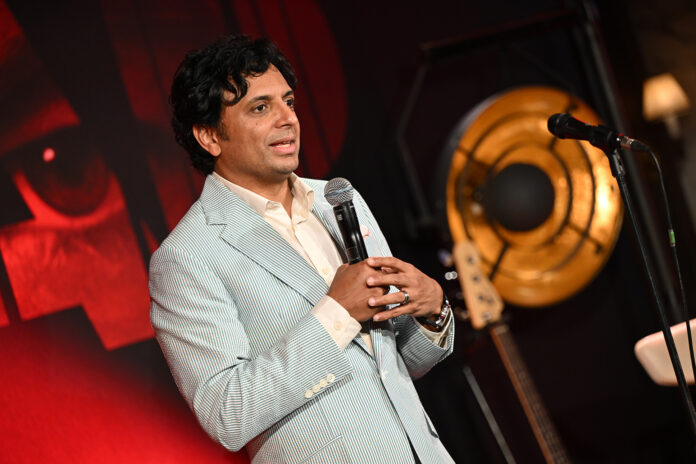Warner Bros. Pictures presents “Trap,” a gripping new thriller from M. Night Shyamalan, featuring the emerging talent of music star Saleka. The film centers on a father and his teenage daughter who find themselves caught up in a dark and sinister event during a pop concert.
Directed and written by Shyamalan, “Trap” features a star-studded cast, including Josh Hartnett, Ariel Donoghue, Saleka Night Shyamalan, Hayley Mills, and Allison Pill. The production team consists of Ashwin Rajan, Marc Bienstock, and Shyamalan, with Steven Schneider serving as the executive producer.
The journey to “Trap” began uniquely for Ariel Donoghue, who had her initial meeting with Shyamalan to discuss her role as Riley interrupted by a technical glitch. Unable to speak, Shyamalan and Donoghue resorted to mime to communicate during their Zoom call.
True to Shyamalan’s filmmaking tradition, the entire cast gathered for a script table read before filming began. Producer Marc Bienstock described this process as the moment when “the third dimension is brought into the two-dimensional script—the actors breathe life into characters that have only existed on paper.”
During the filming of a crucial scene set at the Lady Raven concert, portrayed by Saleka, the filmmakers used earwigs for the audience to lower the concert music for clear recording of the actors’ dialogue, while allowing extras to continue dancing to the stage music.
To depict the sold-out Lady Raven concert authentically, extensive visual effects were employed under the supervision of Will Towle. A LiDAR scan created a 3D version of the venue, and performers were filmed against a green screen. The team used 2D sprites and 3D models to overcome limitations of 2D renders, and motion capture provided a range of movements for the 3D models. This meticulous approach allowed 300 extras to be multiplied, filling the 15,000-seat venue where Cooper and Riley attend the concert.
Overall, “Trap” includes over 250 visual effects shots, primarily involving concert crowds. Custom-made signage and advertising were designed specifically for the film, with art director Stephen Depko noting that “everything was created specifically for these fictional companies and then decorated to achieve the desired look and color palette.”
The creative vision behind “Trap” is shaped by M. Night Shyamalan, the acclaimed director, writer, and producer. Alongside his daughter Saleka, Shyamalan developed the film through their collaborative discussions about music and movies. This led to the innovative concept of merging a music-themed narrative with a thriller. The result is a story in which a father and daughter attend a concert, experiencing both the thrill of the event and the encroaching darkness.
Shyamalan views his filmmaking process as a continuous reinvention of himself, tone, and genre. This drive to reinvent excites him, leading him to create smaller, provocative films that aim to connect with global audiences. He seeks collaborators willing to take significant risks, resulting in rare and extraordinary cinematic experiences.
Josh Hartnett, who lives in England with his family, exemplifies the ideal collaborator for Shyamalan. Known for his thoughtful and philosophical nature, Hartnett’s readiness and electric energy impressed Shyamalan. For the role of Cooper, Shyamalan required someone fully committed and willing to take risks, which he found in Hartnett. Audiences are expected to be drawn to “Trap” not only for its unique concept but also for Hartnett’s exceptional performance.
Shyamalan explores the appeal of dark, complex characters, likening them to the fascination people have with dinosaurs—real-life monsters of the past. He finds it challenging and enriching to uncover the humanity in characters who engage in dark deeds, fostering empathy and understanding. This exploration allows audiences to see parts of themselves in these characters, even those who seem profoundly dark.
Regarding his preference for shooting on film, Shyamalan expresses a deep appreciation for its unique qualities. He values the limitations of film, which drive creativity and capture life in a way that digital formats cannot. Film’s organic nature creates a more intimate connection with the audience, offering just enough information to engage their imagination. This approach, combined with his nostalgia for classic films from his youth, contributes to his preference for shooting on film.
Shyamalan’s commitment to authenticity is evident in the concert scenes of “Trap.” Rejecting CGI, he chose to film a real concert to maintain his point-of-view-driven style. Capturing the perspective of characters watching from less-than-ideal seats required a real-time live concert performance, coordinated via headset with the actors and crew. This meticulous planning ensured that the concert footage was authentic and integral to the storytelling, making “Trap” a unique and immersive cinematic experience.
Discover more from SNAP TASTE
Subscribe to get the latest posts sent to your email.



